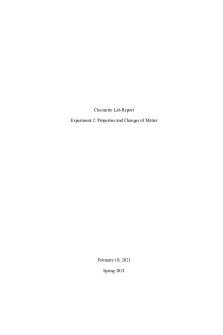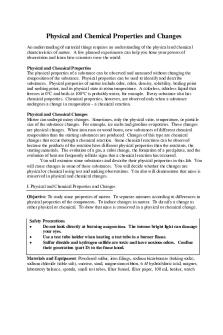Chemical and Physical Properties and Changes Worksheet PDF

| Title | Chemical and Physical Properties and Changes Worksheet |
|---|---|
| Author | Kayla Spiegelman |
| Course | Survey of Chemistry I |
| Institution | Kennesaw State University |
| Pages | 2 |
| File Size | 130.9 KB |
| File Type | |
| Total Downloads | 64 |
| Total Views | 193 |
Summary
Chemical and Physical Properties and Changes Worksheet to practice for exam 1...
Description
Name: __________________________ Class: ____________________ Date: _____________
Classifying Chemical and Physical Properties Introduction to Properties Matter is defined as anything that occupies space and has mass. Different types of matter can be identified based on their properties. -
Physical properties are ones that can be observed or measured without any change in composition.
-
Chemical properties give matter the ability (or inability) to undergo a change that alters its composition.
What physical properties could be observed about this piece of wood? _______Brown_________________ _________Cylinder_____________
____Rough____________________
What would be an example of a chemical property of the piece of wood?
Burning into ash
Practice Classify each of the following properties as chemical (C) or physical (P). _____ 1.
The melting point of iron is 1,538°C. P
_____ 2.
Glass is transparent; light is able to pass through it. P
_____ 3.
Hydrochloric acid can be neutralized in the presence of baking soda. C
_____ 4.
Copper is ductile; it can be drawn and stretched into a wire. P
_____ 5.
Ethanol is highly flammable. C
_____ 6.
Iron, when exposed to water, will form rust. C
_____ 7.
Table sugar will dissolve completely in water. P
_____ 8.
Diamonds are one of the hardest substances in nature. P
_____ 9.
Elemental sulfur is yellow with a rotten egg odor. P
_____ 10. Ice is very brittle and can be broken apart easily. P Written by James Dauray
http://www.aurumscience.com
Page 1
Introduction to Changes Matter can be altered in many different ways. If a substance is changed in such a way that the structure of its molecules is intact, it is considered a physical change. Physical changes do not change the identity of the substance, just its form. If the molecules of the substance are altered and made into completely different ones, it is considered a chemical change.
Practice Classify each of the following changes as chemical (C) or physical (P). _____ 1.
An ice cube melts, then evaporates.
_____ 2.
Hydrogen and oxygen gas combine to form water.
_____ 3.
A beaker of saltwater is boiled until only the salt is left behind.
_____ 4.
A piece of paper is torn into several smaller pieces.
_____ 5.
Gasoline combusts in the engine of a car, releasing carbon dioxide and water vapor.
_____ 6.
An egg is boiled until it becomes solid.
_____ 7.
A scoop of sugar is placed in a blender and ground into a fine powder.
_____ 8.
Wood scraps are placed into a chipper, which turns them into sawdust.
_____ 9.
A mixture of red and blue marbles is separated and sorted.
_____ 10. A plant performs photosynthesis. _____ 11. Baking soda is heated, causing it to decompose into calcium and carbon dioxide. _____ 12. Milk is left sitting out too long, and it sours. _____ 13. A stainless steel pan is heated on the stove. _____ 14. A pellet of sodium metal is cut into two pieces with a knife. _____ 15. A pellet of sodium metal is placed into water, causing an explosion. _____ 16. Sulfuric acid is poured onto a piece of limestone rock, causing bubbling and fizzing. _____ 17. A helium balloon is popped. _____ 18. Electricity is conducted through a long copper wire....
Similar Free PDFs

Physical and Chemical Changes
- 2 Pages

Exploring Chemical Physical Changes
- 10 Pages

Properties and Changes of Matter
- 18 Pages
Popular Institutions
- Tinajero National High School - Annex
- Politeknik Caltex Riau
- Yokohama City University
- SGT University
- University of Al-Qadisiyah
- Divine Word College of Vigan
- Techniek College Rotterdam
- Universidade de Santiago
- Universiti Teknologi MARA Cawangan Johor Kampus Pasir Gudang
- Poltekkes Kemenkes Yogyakarta
- Baguio City National High School
- Colegio san marcos
- preparatoria uno
- Centro de Bachillerato Tecnológico Industrial y de Servicios No. 107
- Dalian Maritime University
- Quang Trung Secondary School
- Colegio Tecnológico en Informática
- Corporación Regional de Educación Superior
- Grupo CEDVA
- Dar Al Uloom University
- Centro de Estudios Preuniversitarios de la Universidad Nacional de Ingeniería
- 上智大学
- Aakash International School, Nuna Majara
- San Felipe Neri Catholic School
- Kang Chiao International School - New Taipei City
- Misamis Occidental National High School
- Institución Educativa Escuela Normal Juan Ladrilleros
- Kolehiyo ng Pantukan
- Batanes State College
- Instituto Continental
- Sekolah Menengah Kejuruan Kesehatan Kaltara (Tarakan)
- Colegio de La Inmaculada Concepcion - Cebu












